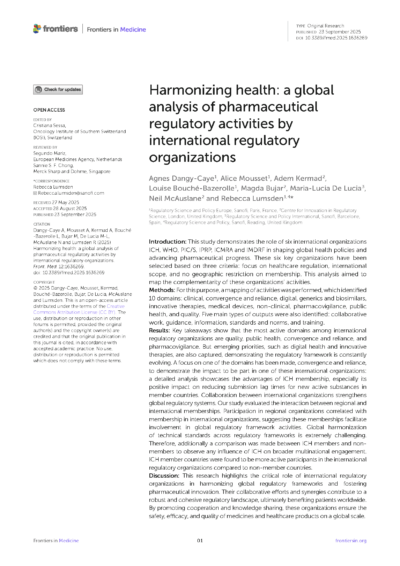We’re pleased to share our latest publication in Frontiers in Medicine, developed in collaboration with Sanofi, exploring how international regulatory organisations are shaping global pharmaceutical policy.
Data from our Growth and Emerging Markets Metrics (GEMM) programme provided insights on the use of reliance pathways across 10 emerging markets and trends in submission lag before and after ICH engagement.
Introduction
This study demonstrates the role of six international organizations ICH, WHO, PIC/S, IPRP, ICMRA and IMDRF in shaping global health policies and advancing pharmaceutical progress. These six key organizations have been selected based on three criteria: focus on healthcare regulation, international scope, and no geographic restriction on membership. This analysis aimed to map the complementarity of these organizations’ activities.
Methods
For this purpose, a mapping of activities was performed, which identified 10 domains: clinical, convergence and reliance, digital, generics and biosimilars, innovative therapies, medical devices, non-clinical, pharmacovigilance, public health, and quality. Five main types of outputs were also identified: collaborative work, guidance, information, standards and norms, and training.
Results
Key takeaways show that the most active domains among international regulatory organizations are quality, public health, convergence and reliance, and pharmacovigilance. But emerging priorities, such as digital health and innovative therapies, are also captured, demonstrating the regulatory framework is constantly evolving. A focus on one of the domains has been made, convergence and reliance, to demonstrate the impact to be part in one of these international organizations: a detailed analysis showcases the advantages of ICH membership, especially its positive impact on reducing submission lag times for new active substances in member countries. Collaboration between international organizations strengthens global regulatory systems. Our study evaluated the interaction between regional and international memberships. Participation in regional organizations correlated with membership in international organizations, suggesting these memberships facilitate involvement in global regulatory framework activities. Global harmonization of technical standards across regulatory frameworks is extremely challenging. Therefore, additionally a comparison was made between ICH members and non-members to observe any influence of ICH on broader multinational engagement. ICH member countries were found to be more active participants in the international regulatory organizations compared to non-member countries.
Discussion
This research highlights the critical role of international regulatory organizations in harmonizing global regulatory frameworks and fostering pharmaceutical innovation. Their collaborative efforts and synergies contribute to a robust and cohesive regulatory landscape, ultimately benefiting patients worldwide. By promoting cooperation and knowledge sharing, these organizations ensure the safety, efficacy, and quality of medicines and healthcare products on a global scale.
Dangy-Caye A, Mousset A, Kermad A, Bouché-Bazerolle L, Bujar M, De Lucia M-L, McAuslane N and Lumsden R (2025) Harmonizing health: a global analysis of pharmaceutical regulatory activities by international regulatory organizations. Front. Med. 12:1636269. doi: 10.3389/fmed.2025.1636269

